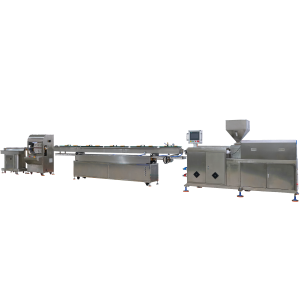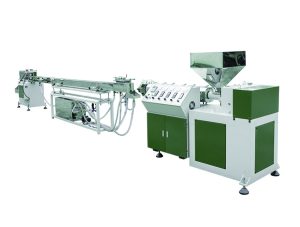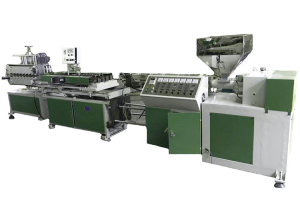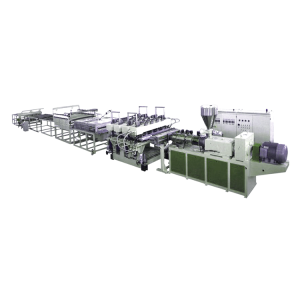I. Extrusion System: High-Torque Plasticization & Pressure Stability
Specialized Screw & Engineering Plastic Compatibility
- Screw Parameters: Diameter 45–65 mm, L/D ratio 28:1–32:1. Ultra-high L/D (32:1) extends plasticization time for high-temperature engineering plastics (e.g., PEEK, PPS), combining deep-feed section (anti-bridging) and abrupt transition zone (compression ratio 3.5:1) for rapid melt homogenization.
- Corrosion Resistance: For acidic byproducts of fluoropolymers (PVDF), bimetallic alloy screw + chrome-plated barrel (surface hardness ≥HRC 60) → lifespan ↑300%.
- Drive System: 7.5–18.5 kW vector-controlled motor + planetary gearbox (15:1 reduction) → output torque 4500 N·m, ensuring stable extrusion of high-viscosity melts (e.g., PC).
High-Pressure Melt Delivery Control
- Dual-Stage Pressure Barrier:
- 80-mesh double-layer screen at die head → back pressure stabilized at 35 MPa;
- Optional melt gear pump (±0.5% precision) eliminates pressure pulsation in crystalline materials (e.g., POM).
- Thermal Management Strategy:
Material Barrel Temp. Zones (°C) Pressure Compensation PEEK 380/390/400/395 Constant temp/pressure → prevents thermal degradation PA66 260/270/280/275 Rapid crystallization transit → prevents bubbles
II. Calibration & Cooling: Precision Rod Concentricity Control
Stepped Calibration Sleeve Structure
- Three-Zone Progressive Cooling:
- Inlet Zone: High-pressure mist quenching (10–15°C water) → locks surface morphology;
- Transition Zone: Vortex slow cooling (25–30°C water) → reduces internal stress;
- Stabilization Zone: Constant-temp circulation (±1°C) → diameter tolerance ≤±0.1 mm (Φ300 mm rod).
- Thermal Deformation Compensation: 0.5 mm PTFE thermal spacer between die and sleeve → blocks radial deviation from heat conduction.
Air-Cooled Crystal Elimination
For nylon (PA) post-crystallization, IR thermometry + air-ring cooling dynamically adjusts wind speed → core temp gradient <5°C/min, suppressing “core whitening” defects.
III. Haul-off & Cutting: Ultra-Low Speed Synchronization
Dual-Mode Haul-off
- Caterpillar Type: V-grooved rubber clamps → friction ↑ for Φ10 mm thin rods (traction force ≥800 N);
- Roller Type: Silicone-coated rolls for Φ250+ mm rods → linear pressure adjustable to 20 N/cm².
- Sync Precision: Servo motor + encoder feedback → speed deviation <0.05% at 0.5–1 m/min ultra-low speed.
Stress-Free Cutting Solutions
- Saw Cutting: Carbide circular blade (Φ450 mm) + hydraulic feed → vibration <5 μm (for PEEK rods);
- Chip-Free Cutting: Ultrasonic blade (20 kHz) for recycled rods → heat-affected zone <0.2 mm.
- Product Rack: Pneumatic lift storage (2-ton capacity) → horizontal stacking prevents bending.
IV. Smart Control: Engineering Plastic Process Database
Multi-Parameter Coupling Control
- Temp-PID Link: 32 independent zones (±0.5°C) → overshoot <1% (critical for PPS’s 8°C process window);
- Pressure-RPM Loop: Melt pressure sensor regulates screw speed → flow fluctuation ≤±1.5%.
- Adaptive Recipe System: 50+ predefined process packages (e.g., PEI melt strength curve) → one-click switching.
Predictive Maintenance Module
- Vibration sensors monitor gearbox bearings → alerts at >15% lifespan deviation;
- Current ripple analysis → screw wear detection accuracy 92%.
V. Applications & Process Optimization
| Material | Rod Applications | Key Technical Measures |
|---|---|---|
| PEEK | Aerospace bearings, implants | 400°C die + argon shielding → anti-oxidation |
| PVDF | Semiconductor etch tank supports | Electro-polished flow path + titanium alloy sleeve → anti-corrosion |
| POM | Precision gears, auto clips | Quench cooling (5°C/s) → suppresses shrinkage |
Conclusion: Technical Barriers & Industry Value
The HPJX-RE-02 resolves three industry challenges—core bubbles, crystalline spots, and diameter drift—via 35 MPa backpressure stability and ±0.1 mm concentricity control. Its modular design (e.g., quick-change screw kits) enables flexible production from generic plastics to specialty polymers, while 300 mm max. diameter bridges the domestic gap in large-scale PEEK rod continuous forming. Future integration of digital twin models may enable visual调控 of internal crystalline structures.







